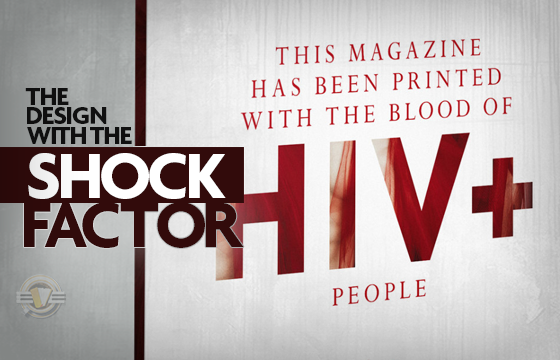The Design with the Shock Factor

Would you touch a magazine that was printed with HIV+ blood?
A book printed in blood sounds like the purview of the macabre. But it can also be a pretty amazing design project, and the HIV+ element naturally generated a big response.
I’m late to the party in discovering and discussing this. Back in April 2015, I was still doing an army crawl through my days, with a child on each ankle and my eyes barely open. Meanwhile, Saatchi & Saatchi (Switzerland), along with German magazine Vangardist, released 3,000 copies of an issue with the blood of HIV+ donors infused into the ink.
Blood in the ink. HIV+ blood, at that. What a compelling story that doth make…
So what was the story, then?
The problem preceding it was that people rarely talked about HIV anymore—an alarming misfortune, what with there being an 80% increase in new cases in the 10 years since 2004. (Source). And the topic was still attached to misinformed ideas. Like that it’s a gay thing. Or that you can catch it by using the same drink bottle as someone with the virus. Or that an infected person can’t live a long and healthy life with it, chances of infecting another person low. The reality is that even pregnant women who are HIV positive can safely have their baby without transmitting the infection.
The biggest challenge to managing HIV wasn’t medical or biological, but social—the stigma perpetuated by silence and misinformed ideas. An estimated half of new cases are detected late, due to lack of testing caused by this stigma.
Vangardist wanted to combat this challenge, and reignite the topic. And so their editorial team paired with global advertising agency Saatchi & Saatchi, to creatively achieve that.
“With this unique project,” Jason Romeyko, Saatchi & Saatchi’s Executive Creative Director said, “we want to create a response in a heartbeat by transforming the media into the very root of the stigma itself—by printing every word, line, picture and page of the magazine with blood from HIV+ people. By holding the issue, readers are immediately breaking the taboo.“
The idea was daring, and—working around paranoia and policies—difficult to actually turn into a product on a shelf.
They got endorsements from Harvard University and Innsbruck Medical University to reassure all involved there would be zero chance of infection, but the project still faced many challenges: Finding donors (difficult because the donors would also be the story, not just the ink). Obtaining the blood itself while still live (normally a hospital would kill a virus by heating the blood and throwing it away). Finding sponsors to transport the blood (because you can’t just drive blood around in your own car using a Tupperware container). Collaboration challenges (because when an editorial team are in the car with an advertising agency, they can’t both drive).
And then there was a legal snag: there needed to be a warning on the magazine.
But such a warning—in conventionally small notation—would take away shock value, and encourage the stigma, as it implied this was something dangerous. So it was that the legal requirement brought about another creative solution: they made it a moral dilemma, with responsibility put on the reader.
They didn’t make the warning conventionally small, but displayed it dominantly across the cover of the magazine, and enclosed it in a plastic seal. The would-be reader had to break the seal of the outer wrapper to access the magazine. The strap-line on the seal said: “Break the seal, help break the stigma.”
Naturally, after this magazine issue was released, it provoked plenty of attention. Handling the magazine was safe, but the shock factor was large anyway. Many people had a ‘Would you or wouldn’t you touch the magazine?’ conversation, and so found out their own thoughts and attitudes regarding HIV. Social media interactions numbered over 7 million. Over 55 million people saw media exposure of the campaign, and it’s picked up 26 awards worldwide.
Amazing work by Saatchi & Saatchi—with such innovation, this would surely be a collector’s item! I’d love to get my hands on it.
If you’re interested to know the facts of HIV, here are some resources:


18 Nov 2016
Personally, I’d be slow to touch any kind of blood-ink, despite the scientific assurances of safety. I don’t think it would make a difference to me what else was in the mix.
“The biggest challenge to managing HIV wasn’t medical or biological, but social.” Actually, I think worldwide the biggest challenge is that most developing countries can’t afford the price-tag on the medication necessary to make it a live-with disease. Which puts HIV into the large category of “diseases people don’t have to die of but do anyway.” Damn greed.
19 Nov 2016
How did I not know about this? What a cool thing.
HIV is the leprosy of our time.
As to Deborah’s comment about “diseases people don’t have to die of”, that is a terrifyingly large category. Similarly I see a lot more amputees now as small bites can lead to infection and motorcycle accidents almost invariably lead to losing a leg. I’m sure there is money around, it just seldom gets to the right places.
21 Nov 2016
Cost of antiretroviral drugs of course vary from country to country, being highest in the developed ones (to the surprise of nobody), so I was interested to know how much it would cost an individual in NZ, with HIV. It was simple enough to discover the total cost—Pharmac’s 2015 review reports a $29.53million gross cost of antiretrovirals—but it was less easy to find a typical cost for the individual, once any subsidies are in place. I couldn’t even find criteria for the subsidies. It seems folks with HIV get this information from respective specialists, personally, during treatment consultations. Nobody’s helpfully put the information on the internet, that I can find.
25 Nov 2016
Perhaps if it wasn’t facing the social stigma that it is, there might be more work being done on the physical issues in developing countries.
25 Nov 2016
‘Physical issues’ — do you mean developing affordable medications to manage it?
01 Dec 2016
My comment was supposed to be a reply to Deborah’s comment regarding the biggest challenge worldwide.
I clearly clicked on the wrong ‘Reply’, but yes, I was referring to developing affordable medications so that those in developing countries can afford them.